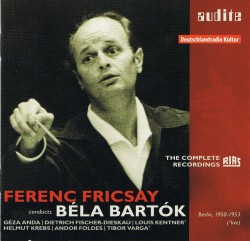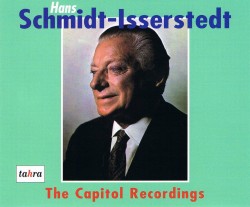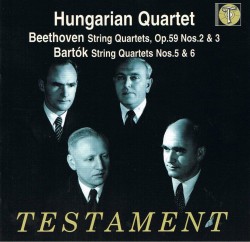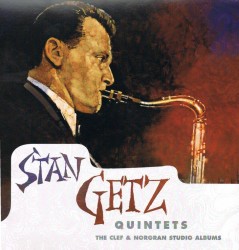 The deservedly honoured Hungarian conductor Ferenc Fricsay (1914-1973) led the RIAS Symphony Orchestra from its inception in 1949 until 1963. In 1950 he signed an exclusive contract with DG and although he made a few recordings with the Berlin and Vienna Philharmonics, it is with the RIAS that his recorded legacy rests. At the Franz Liszt Academy in Budapest he had studied with Bartok, Kodaly and Dohnanyi all of whom he acknowledged as having the greatest influence in his interpretation of his county’s music and, of course, on the entire repertoire, orchestral music, concerti, and certainly opera. Audite has released a three CD set containing the complete RIAS recordings of Bartok performances from 1951 through 1953 (Audite 21.407, 3 mono CDs). There are no duplications of any performances that have been issued by DG. Included are concerto performances with his landsmen violinist Tibor Varga and pianists Géza Anda, Louis Kentner and Andor Földes, each of whom were his first choices... they shared the same musical language. The three well-filled CDs contain the Violin Concerto No.2; Piano Concertos 2 & 3 and Rhapsody for Piano and Orchestra; Two Portraits, op.5; Cantata Profana (Fischer-Dieskau, RIAS Kammerchor & St. Hedwig’s Cathedral Choir); Music for Strings, Percussion and Celesta; Dance Suite BB86; and the Divertimento for String Orchestra. It would be no exaggeration to state that these are all definitive performances, played with complete understanding and verve, heard in excellent sound from the archives of Deutschlandradio who licenced them to Audite.
The deservedly honoured Hungarian conductor Ferenc Fricsay (1914-1973) led the RIAS Symphony Orchestra from its inception in 1949 until 1963. In 1950 he signed an exclusive contract with DG and although he made a few recordings with the Berlin and Vienna Philharmonics, it is with the RIAS that his recorded legacy rests. At the Franz Liszt Academy in Budapest he had studied with Bartok, Kodaly and Dohnanyi all of whom he acknowledged as having the greatest influence in his interpretation of his county’s music and, of course, on the entire repertoire, orchestral music, concerti, and certainly opera. Audite has released a three CD set containing the complete RIAS recordings of Bartok performances from 1951 through 1953 (Audite 21.407, 3 mono CDs). There are no duplications of any performances that have been issued by DG. Included are concerto performances with his landsmen violinist Tibor Varga and pianists Géza Anda, Louis Kentner and Andor Földes, each of whom were his first choices... they shared the same musical language. The three well-filled CDs contain the Violin Concerto No.2; Piano Concertos 2 & 3 and Rhapsody for Piano and Orchestra; Two Portraits, op.5; Cantata Profana (Fischer-Dieskau, RIAS Kammerchor & St. Hedwig’s Cathedral Choir); Music for Strings, Percussion and Celesta; Dance Suite BB86; and the Divertimento for String Orchestra. It would be no exaggeration to state that these are all definitive performances, played with complete understanding and verve, heard in excellent sound from the archives of Deutschlandradio who licenced them to Audite.
 Another conductor of note from about the same time was Hans Schmidt-Isserstedt (1900-1973), the German conductor who, in 1945 was invited by the military authorities to form an orchestra for the North German Radio in Hamburg. In six months the NWDR Symphony Orchestra was a reality and Schmidt-Isserstedt conducted their first concert in November 1954. The very next year he made a series of LPs released by Capitol and referred to as The Capitol Recordings. These discs have virtually disappeared but TAHRA has unexpectedly issued them on three CDs (TAH 694-696, mono). Mozart, we are told, was the conductor’s favourite composer and it is appropriate that Eine Kleine Nachtmusik is the first work on the first disc. It is interesting that no matter how many times we have heard this little serenade it doesn’t become tiresome or ho-hum. This sparkling performance is freshly appealing, reflecting a real joy of music-making. Noticeable immediately is the very high quality of the sound, articulate and dynamic in a very suitable acoustic (possibly the Musikhalle, the liner notes mention no venue). The Haydn Symphony No.94 follows and then the Schubert 5th. Beethoven’s 3rd Piano Concerto, again we are told, was the conductor’s favourite and many soloists enjoyed playing it with him. Here Ventsislav Yankov is the soloist in a pensive performance of unusual beauty. There is a moment in the first movement cadenza when the piano disappears and fades up a second or two later. The tempi in Brahms Second Symphony are well judged in a performance that is lyrical above all and never ponderous. I put this recording right behind Bruno Walter’s 1953 New York Philharmonic recording as my preferred version. Extended excerpts from Rosamunde are followed by six extracts from The Ring. The playing throughout is of the very highest calibre from all sections but the strings are exceptionally sonorous as are the brass. Not a set for everyone but I am pleased with it.
Another conductor of note from about the same time was Hans Schmidt-Isserstedt (1900-1973), the German conductor who, in 1945 was invited by the military authorities to form an orchestra for the North German Radio in Hamburg. In six months the NWDR Symphony Orchestra was a reality and Schmidt-Isserstedt conducted their first concert in November 1954. The very next year he made a series of LPs released by Capitol and referred to as The Capitol Recordings. These discs have virtually disappeared but TAHRA has unexpectedly issued them on three CDs (TAH 694-696, mono). Mozart, we are told, was the conductor’s favourite composer and it is appropriate that Eine Kleine Nachtmusik is the first work on the first disc. It is interesting that no matter how many times we have heard this little serenade it doesn’t become tiresome or ho-hum. This sparkling performance is freshly appealing, reflecting a real joy of music-making. Noticeable immediately is the very high quality of the sound, articulate and dynamic in a very suitable acoustic (possibly the Musikhalle, the liner notes mention no venue). The Haydn Symphony No.94 follows and then the Schubert 5th. Beethoven’s 3rd Piano Concerto, again we are told, was the conductor’s favourite and many soloists enjoyed playing it with him. Here Ventsislav Yankov is the soloist in a pensive performance of unusual beauty. There is a moment in the first movement cadenza when the piano disappears and fades up a second or two later. The tempi in Brahms Second Symphony are well judged in a performance that is lyrical above all and never ponderous. I put this recording right behind Bruno Walter’s 1953 New York Philharmonic recording as my preferred version. Extended excerpts from Rosamunde are followed by six extracts from The Ring. The playing throughout is of the very highest calibre from all sections but the strings are exceptionally sonorous as are the brass. Not a set for everyone but I am pleased with it.
 The Hungarian Quartet recorded two complete Beethoven cycles for EMI, in 1953 and in 1966 with a change of second violin and cello. Testament has issued a 2 CD package containing two Beethoven Quartets, the op.59 nos.2 & 3 and two Bartok Quartets, nos.5 & 6 (Testament SBT2 161 2 CDs at a reduced price). They were recorded on two consecutive evenings, July 6 & 7 1955 in the Freemasons’ Hall in Edinburgh. The personnel is as in the 1953 cycle. These are exciting performances, excelling their studio versions of all four quartets. The sound is clear with some audience fussing here and there and the recording is missing deep bass. Otherwise, it’s a winner.
The Hungarian Quartet recorded two complete Beethoven cycles for EMI, in 1953 and in 1966 with a change of second violin and cello. Testament has issued a 2 CD package containing two Beethoven Quartets, the op.59 nos.2 & 3 and two Bartok Quartets, nos.5 & 6 (Testament SBT2 161 2 CDs at a reduced price). They were recorded on two consecutive evenings, July 6 & 7 1955 in the Freemasons’ Hall in Edinburgh. The personnel is as in the 1953 cycle. These are exciting performances, excelling their studio versions of all four quartets. The sound is clear with some audience fussing here and there and the recording is missing deep bass. Otherwise, it’s a winner.
 With his seductive, smooth sound and innate sense of phrasing it was a sure thing that tenor sax man Stan Getz would be in the forefront of the Cool Jazz era that arrived in the early fifties. His career took off and he recorded extensively with groups bearing his name, backing soloists and with some bands of the day. Norman Granz of Jazz at the Philharmonic fame recorded the Stan Getz Quintets in nine sessions from 1952 through 1955. Backing Getz were selectively Bob Brookmeyer (valve trombone), Tony Fruscella (trumpet), Duke Williams or John Williams or Jimmy Rowles (piano), Jimmy Raney (guitar), Bill Crow or Teddy Kotick or Bobby Whitlock or Bill Anthony (bass), Frank Isola or Al Levitt or Max Roach (drums). Over the years some of these tracks were scattered across the Verve catalogue but now they all have been assembled, including three unissued tracks, remastered and issued in a 3 CD package of an extraordinary sophisticated design (Verve B0014657-02). Inside is the kind of repertoire and seductive performances one would hear in a small bar or the basement of a jazz club. Very nostalgic listening.
With his seductive, smooth sound and innate sense of phrasing it was a sure thing that tenor sax man Stan Getz would be in the forefront of the Cool Jazz era that arrived in the early fifties. His career took off and he recorded extensively with groups bearing his name, backing soloists and with some bands of the day. Norman Granz of Jazz at the Philharmonic fame recorded the Stan Getz Quintets in nine sessions from 1952 through 1955. Backing Getz were selectively Bob Brookmeyer (valve trombone), Tony Fruscella (trumpet), Duke Williams or John Williams or Jimmy Rowles (piano), Jimmy Raney (guitar), Bill Crow or Teddy Kotick or Bobby Whitlock or Bill Anthony (bass), Frank Isola or Al Levitt or Max Roach (drums). Over the years some of these tracks were scattered across the Verve catalogue but now they all have been assembled, including three unissued tracks, remastered and issued in a 3 CD package of an extraordinary sophisticated design (Verve B0014657-02). Inside is the kind of repertoire and seductive performances one would hear in a small bar or the basement of a jazz club. Very nostalgic listening.



